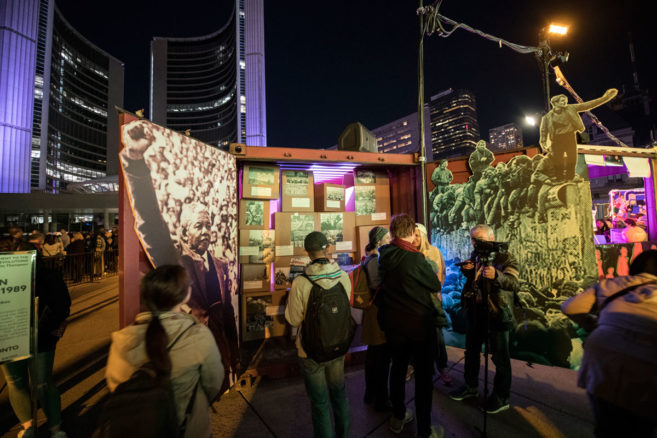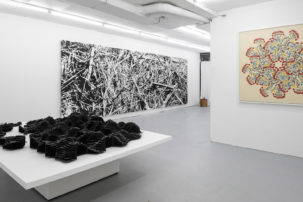Camille Rojas performed Algorithm before an intimate audience during this year’s Nuit Blanche in Toronto. The solo dance performance presented an inquiry into body parts that have been identified as pornographic and then censored by algorithmically enforced online cyber-regulations. Rojas, whose background in ballet informs her contemporary dance practice, moved effortlessly through the space, repeating pedestrian gestures, such as pointing and walking, while tracing out invisible patterns on the gallery floor. She interrupted these acts of pattern-making with bursts of stylized improvisational movement, often emphasizing contact with the ground. Rojas performed without music, which amplified the sounds of her breath, and of her body moving against the plastic-sheet flooring.
Rojas developed the linear patterns that she traced during her performance from algorithmic patterns and symbols used in vision-based pornography filtering—a type of computer science concerned with training computers to recognize pornographic images online. These technologies are sometimes implemented by social media platforms to remove pornographic images in an automated and (supposedly) efficient way. While these algorithms are often presented as objective and scientifically neutral, their biases are seen in the way images of vulvas and breasts are far more strictly regulated than images of phalluses. In Algorithm, Rojas questions these gendered algorithms and their assumed neutrality. Rojas’s tight, beige costume alluded to the content these processes seek to censor, and the path her movements followed mapped the algorithmic filtering patterns onto the gallery floor. The improvisational aspect of the performance permitted an escape from the algorithms of the online world, allowing Rojas and her audience to focus on the spontaneity of flesh and breath.
Rojas performed eight times throughout the evening. I attended the midnight performance, during which we could hear late-night commotion through the open street-level gallery windows. Sounds of cars speeding by and blasting music (Bob Marley and the Wailers’ “Get Up, Stand Up”) as well as remarks from passersby on the nature of what was happening inside the gallery (“That bitch is dancing!”) echoed throughout the otherwise near-silent performance space. Rojas stayed perfectly composed through these interruptions, later telling me that in the intensity of her concentration she didn’t even notice them. But as an audience member, I fixated on these aural transgressions. For me, they spoke to the performance of masculinity. Especially representative of this was the comment “That bitch is dancing.” Much like the ways in which a hidden, biased system limits Rojas’s online autonomy, her in-person, real-life actions were upset by an unseen and almost comical patriarchal voice.
The transgressions that I initially understood as unwelcome and irritating in many ways worked in tandem with Rojas’s performance—they highlighted the concepts of censorship she engaged with. As Rojas interpreted the biased algorithms of cyber-censorship, her focus on her patterns of movement allowed her to censor the profanities and disturbances that intruded on her own performance.
By way of interruption, Algorithm facilitated a potent enactment of the themes that Rojas set out to explore. It also generated an unexpected merging of spaces, as the aural interruptions acted as reminders of the coexistence of public space, both outside of and crossing the permeable boundaries of the gallery. While I found myself fixated on these trespasses, Rojas was able to escape them through her own algorithmically simulative processes.







